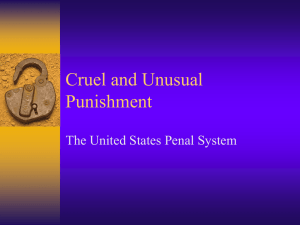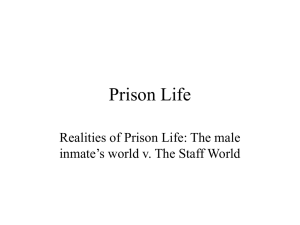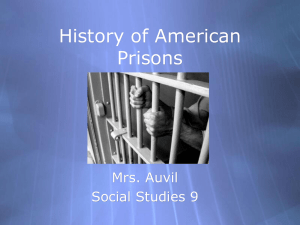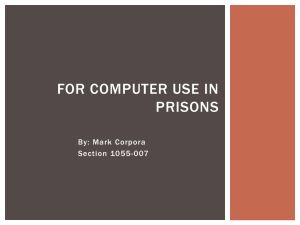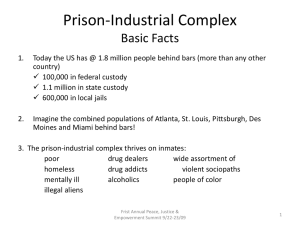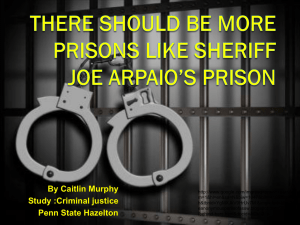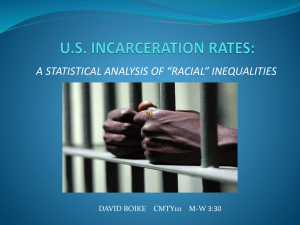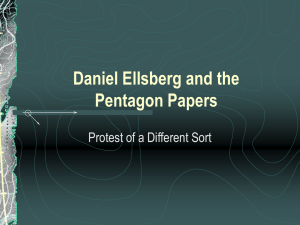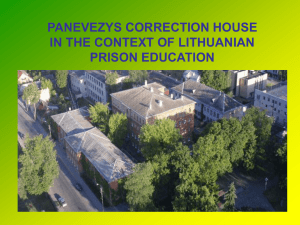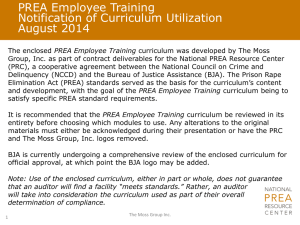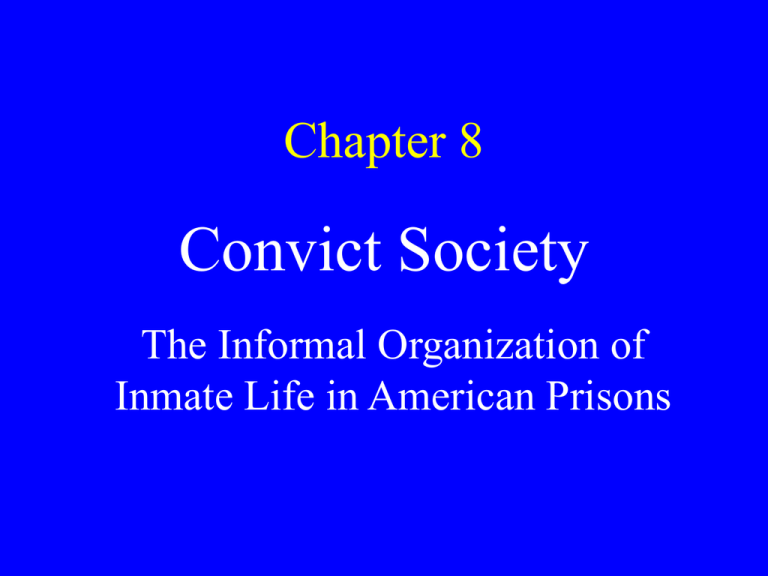
Chapter 8
Convict Society
The Informal Organization of
Inmate Life in American Prisons
Importation Theory
• The status roles and subcultures of the
prison result from the identities established
by inmates before imprisonment
• Prison as a school for crime
• Learning is direct (exchange of information)
and indirect (modeling of violence)
• Inmates associate with those of similar race,
age, background, and type of offense
Deprivation Theory
•
Inmate societies as a response to the
unique hardships that result from
incarceration
1)
2)
3)
4)
5)
Loss of liberty
Loss of access to goods and services
Loss of heterosexual relationships
Loss of autonomy
Loss of security
The Convict Code c. 1960
1. Don’t interfere with the interests of other
inmates; show loyalty to convicts, not to
staff
2. Don’t be nosy, do your own time and mind
your own business
3. Be cool, don’t lose control
4. Keep your dignity, never show weakness
5. Don’t take advantage of other inmates
Recent Changes to Convict Code
• Toughness is essential to identity and survival
• Extreme violence is “expected and accepted”
• Loyalty is expected only to one’s own
racial group
• Results mainly from situational factors, such
as racial makeup of inmate population
• Harsh conditions; lack of treatment and work
The Total Institution
• Bureaucratically administered
• All basic needs met within facility
• Administered for convenience of staff,
not welfare of inmates
• Inmates spend relatively long periods
within its control
• Inmates have similar statuses
Prisonization
• “Desocialization” followed by “resocialization”
– Old identity lost in favor of new one that is
meaningful within institution
– Affects all inmates and staff to some extent
• Degradation ceremonies mark identity change,
such as delousing, interactions with C.O.s
• Learning focuses on survival in new
environment
Learned Helplessness
• Belief that one is powerless to affect
his/her own life
• Being dependant on others for all needs
• Responsibility for actions attributed to
others
Zimbardo’s Prison Experiment
• Inmates and staff affected quickly by
prisonization
• Imprisonment makes even mentally
healthy people behave pathologically
• Incarceration should be used only as a last
resort for the most dangerous offenders
Wheeler’s U-Curve Thesis
• Inmate attitudes surveyed repeatedly over
a 4.33-year period
• Most pro-social attitudes noted in first six
months and last six months of sentence
• Unrealistic expectations and hope for
future explained pro-social attitudes
• Longer sentences may worsen attitudes,
no recovery at end of sentence
Sources of Prisonization
1. Involuntary incarceration
2. Segregation from mainstream society,
significant others, and the opposite sex
3. Complex and unique system of social
roles in prison
4. Imported antisocial identities and
behaviors
5. Degradation ceremonies
Universal Aspects
of Prisonization
1. Taking on the devalued identity of “convict”
2. Learning the customs, organization and
general culture of the prison
3. Changing habits to deal with dangers of
prison life
4. Developing new ways of dealing with,
thinking about, people, such as increasing
social distance and building an “antisocial”
reputation
Factors that
Minimize Prisonization
1.
2.
3.
4.
5.
6.
7.
8.
Serving a short sentence
Having a pro-social cellmate
Having a stable personality
Contacts with noncriminals in the free world
Avoiding deviant activities within the prison
Rejecting the norms of the convict society
Small, treatment-oriented facilities
Low levels of security and/or high levels of
exposure to the outside world
Types of Inmates
• Prosocial inmates: no association with a
criminal subcultures before imprisonment
– Prefer to associate with staff
– No threat to others – orientation is clear
• Anti-social inmates: active in criminal
sub-culture prior to imprisonment
– Seek shortest, sentence, least deprivation
possible
– Epitome of convict code
Types of Inmates (continued)
• Pseudo-social inmates: many contacts
within the prisoner, staff, and free-world
cultures but are loyal to none
– The politicians” and “merchants” of the prison
– Manipulate others for gain
• Asocial inmates: emotionally damaged, few
social skills
– Often “state-raised youths”
– Oriented to life within the institution
Prison Gangs
• Began in 1950s; little concern until 1970s
• Organized along racial lines, also by region
among Mexican groups
– Mexican Mafia (S. CA) , La Nuestra Familia
(N. CA); Texas Syndicate, Black Guerilla
Family, Aryan Brotherhood, Aryan Circle
• Allied with free world groups
• Responsible for much of the drug trade,
violence in prisons
Prison Gangs (continued)
• Percentage of involved inmates varies
with security level
– 30%+ in maximum security units
– 25% in medium security units
– 16% in minimum security units
• Power and size has grown immensely in
last 15 years
Prison Gang Violence
• A condition of gang membership
• Main method of gaining status
• “Rolling your bones” – participating in a
murder attempt to earn membership
• Common targets are members who are
suspected of disloyalty or disobedience
• Hard to collect reliable data on gangs
The Prison’s Informal Economy
•
Inmates obtain desired items and services:
1.
2.
–
–
As gifts from people in free society
From the prison canteen or commissary
Cash is contraband
Canteen purchases are made with credits
on money placed in account
3. Through smuggling by staff and visitors
4. By stealing and making items
•
Any item not explicitly permitted is
contraband
Informal Economy (continued)
•
•
•
•
•
•
Easily concealed items bartered in complex networks
Cash required for drugs, alcohol
All transactions violate rules
Most ignored as nuisance violations
Manipulation, deceit common source of violence
Lockdowns, shakedowns attempt to eliminate
dangerous contraband
Prison Riots
• Riots best explained by deprivation thesis
–
–
–
–
Crowding
Extremes of control
Loss of status
Vague release policies
• Some analysts fear U.S. prisons are
increasingly dangerous, disturbance-prone
• African Americans disproportionately
involved in violence – importation factor?
American Correctional Association:
Causes of Riots
•
•
•
•
•
•
•
Enforced idleness
Lack of programs
Poor parole policies
Overcrowding
Poor management
Inhumane treatment
Disruptions of status hierarchies
Sex in Prison
• Dispositional homosexuality: individual
prefers partners of the same sex
– Imported from free world
– At high risk of victimization in prison
• Situational homosexuality: temporary
adaptation to sexually segregated
environment
– Strives to maintain heterosexual self-image
– Dominant role equated with masculinity
Sex in Prison
• Consensual and coerced sex more
common than rape
• Up to 20% of inmates may suffer coercion
– Fear of gang rape (myth?) used to coerce
• Rape often interracial, gang related
• “Punks” treated harshly, sex lacks affection
• Amount of sex and drug use predicted by
harshness of prison life (deprivation)
Legitimizing Sex for Inmates
• Conjugal visits: Inmate can earn private,
overnight visit from spouse
– Allowed in five states, Mexico, Europe
– Only benefits married inmates
• Home Furloughs: visits home, usually for
those nearing release date, often to seek job
– Substance use, diseases are problems


